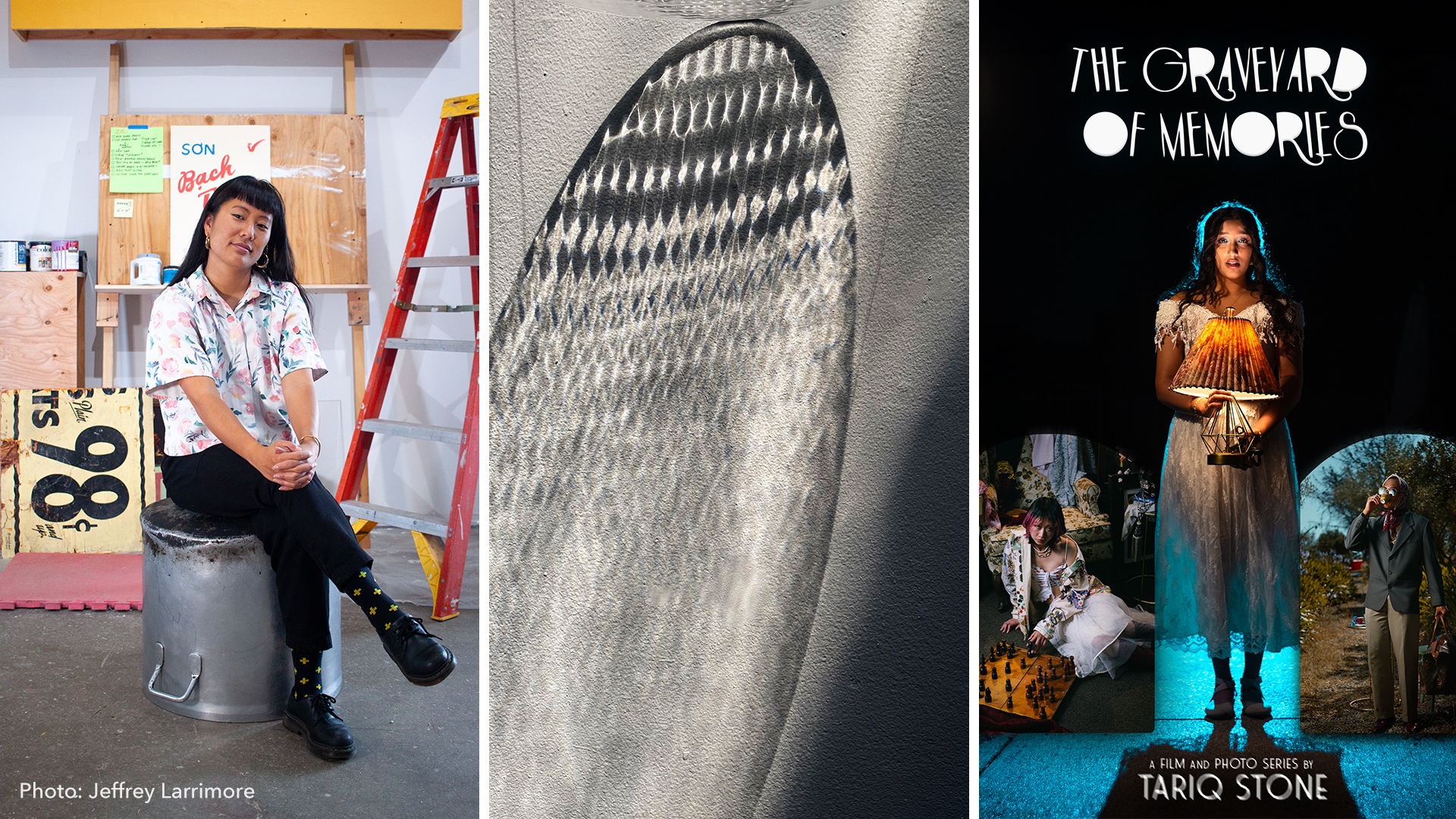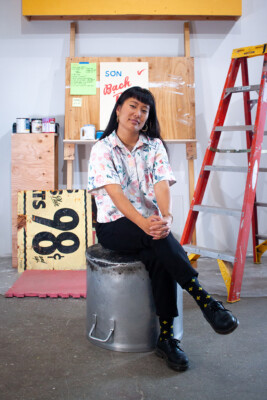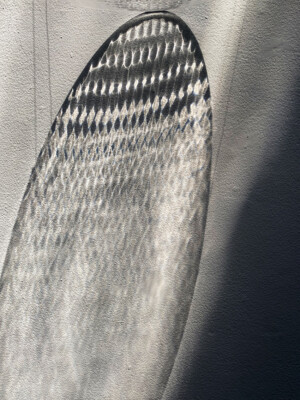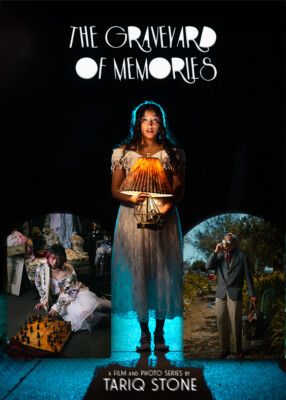
FOR IMMEDIATE RELEASE
The Artist in Residence Program at Recology San Francisco is thrilled to announce exhibition dates for current artists-in-residence Michelle “Meng” Nguyễn, Ron Moultrie Saunders, and CCA undergraduate Tariq Stone.
Friday, September 20, 2024 from 5 – 8 PM
Saturday, September 21, 2024 from 12 – 3 PM
Tuesday, September 24, 2024 from 5-7:30pm with artist talk by Tariq Stone at 6pm (401 Tunnel), Ron Moultrie Saunders at 6:30pm (503 Tunnel), and Michelle “Meng” Nguyễn at 7pm (503 Tunnel).
Admission is free and open to the public, no reservation required. All ages are welcome and the site is wheelchair accessible.
Location
Recology Art Studios
503 and 401 Tunnel Avenue, San Francisco

Photo: Jeffrey Larrimore
Michelle “Meng” Nguyễn
Chợ Việt Kiều
Written by Weston Teruya
Michelle “Meng” Nguyễn’s Chợ Việt Kiều is an installation of hand painted signs, storefront facades, food carts, and other street vendor furnishings that evoke the dense, colorful street life and urban architecture of Saigon, here in a San Francisco gallery space — offering the diasporic Vietnamese marketplace that the exhibition’s title suggests. It is equal parts homage to family and local community along with her experiences spending time with sign painters and store owners in Vietnam over the years.
A professional sign painter and designer by trade, Nguyễn usually creates discrete signage to be incorporated into others’ spaces. Here, she builds out her own imaginative context that highlights the ways signs can be endlessly expansive, skillfully crafted letterforms. They carry linguistic legacies, cultural ecosystems, as well as humor & personal stories. They are integral parts of storefronts that help anchor neighborhood economies and serve as steps along transnational familial migrations. The square includes a restaurant, an auto body shop, an electronic repair store, a small alleyway, and her own sign shop. She embraces and leaves visible the unpredictability of found objects and textures in her building process, giving the installation a legible humanness. Being able to perceive the constructed-ness of the forms reminds us that these spaces are built through labor, communities of people, and networks of support. If Chợ Việt Kiều is an imagined space for overseas Vietnamese community, it is an invitation to join in building that place together.
Michelle “Meng” Nguyễn is a Vietnamese American designer, illustrator, and sign painter, born and raised in San Francisco, California. She enjoys working with various mediums and surfaces, welcoming the blend of traditional methods of sign painting with what modern technologies and tools can offer. She is influenced by the talent of her peers in the industry, vintage packaging design found at thrift stores, and hand painted signage from countless countries. She also finds inspiration through the community Tight Quarters continue to bring — an art collective and former gallery space she ran with Orlie Kapitulnik, Amanda Durbin, and Jeffrey Larrimore.
 Ron Moultrie Saunders
Ron Moultrie Saunders
The Absence of Black Presence
Written by Weston Teruya
Ron Moultrie Saunders came to Recology intending to gather evidence of San Francisco’s Black community in what he could find in the Public Recycling and Reuse Area. Instead, he quickly realized that these materials were either exceedingly rare or illegible amidst the piles. So he created The Absence of Black Presence, a photographic series and sculptural installations that explores those missing traces and holds visual space for his resilient but shrinking community even as he acknowledges the pains of generational displacement. In his photographic work, Saunders often incorporates his silhouette and layers of other textures to explore Black histories & mythologies, interiority, and relationships to the world around us. In this exhibition, he primarily utilizes cyanotype photogram prints on found papers and other surfaces, using the outline of his hands and other parts of his body as a symbolic placeholder for a larger community body: an abstraction and distancing inherent to the artmaking process. The cyanotypes are created by objects and shadows blocking the sun from hitting the light sensitive coating on a surface for an adequate amount of time. The figures and things are no longer there, but leave their mark. The works become records of time and transformation, and are sensitive to the longer arcs of seasons and daylight.
In framing this consideration of presence in absence, Saunders invokes this passage from the prologue of Ralph Ellison’s Invisible Man: “I am invisible, understand, simply because people refuse to see me…When they approach me they see only my surroundings, themselves, or figments of their imagination–indeed, everything and anything except me.” Not only does he declare that he and his community have continued to carve out space in the city, he turns responsibility of this displacement back outward: it is not a simple disappearance of Black folks, it is the stubborn refusal of legislatures, property owners, developers, and others to do the deeper work of valuing people and making space. Invisibility has a peculiar slipperiness: it is an erasure that infects policy decisions, funding, and a basic humanness, but as Saunders references in some of his works where his figure is layered with plant forms, blending into the woods was also how captive Black folks escaped slavery. It can be how subversive cultural forms can take root and thrive. By weaving together shadows, patterns, and optical effects from light diffused and refracted through glass, Saunders uses photographic processes to visually embrace the generative features of transparency and the gaps between forms, not just a sense of lack. What is not there or not fully perceptible is just as important in framing and making visible what is there.
Ron Moultrie Saunders is a photographic artist and landscape architect. Originally from Jamaica, Queens, New York, he currently lives in the Bayview neighborhood of San Francisco. He creates photograms: photographs that are made without the use of a camera. He is a co-founding member of 3.9 Art Collective, a charter member of Minnesota Street Projects Artist Studio Program, and a recipient of two Individual Artist Grants from the San Francisco Arts Commission and a Kala Art Institute Fellowship. He has exhibited at the San Francisco International Airport, San Luis Obispo Museum of Art, Rena Bransten Gallery, and at the San Jose ICA and completed two public projects for BART in 2023.
 Tariq Stone
Tariq Stone
The Graveyard of Memories
Written by Weston Teruya
In The Graveyard of Memories, a loosely interconnected short film, series of photographic portraits, and sculptural installations, Tariq Stone imagines the speculative history of our discarded objects. Through these lushly captured vignettes, he asks us to consider the paths our trash charted before it ended up in the waste pile. What is the emotional life of our things?
In his film, Juno, Stone’s deeply empathetic, titular character can only experience life through the echoes of others’ memories that she psychometrically calls forth from the trash she finds strewn about. The liveliness of some of these recollections contrasts with the melancholic detachment Juno experiences by only living lives that aren’t her own. As we see her recount and move through these object histories, all characters, even in photographs, are played by the same performer, reinforcing her supreme loneliness even in a world filled with people and their thoughts. Stone’s photographic series gives us another angle on these material stories, depicting densely staged, surrealist scenes of other people engaging with their couches, clocks, tubs, childhood play sets, and TVs. In these, we’re asked to unpack and reconstruct the potential narratives from the assembled costumes, symbols, and characterisation, paralleling Juno’s inner journey.
By inviting us to dive deep into the memory of things, to consider the roles they play in our day to day life, Stone challenges us to engage with our world of stuff–and the people around us–with more care and intention. As we can see in Juno’s narrative, this doesn’t mean swinging toward hyperconsumption or object fetishism. For the most part, the trash Stone has chosen are not heirloom items that we pass between generations. Instead, his imagined world tasks us with a kind of mindful stewardship that might temper our tumbling rush toward a numb, disposable culture focused on extraction.
Tariq Stone is a San Francisco-based filmmaker and photographer inspired by his photographer father and the TV shows he grew up watching. He creates and tells stories visually through surreal colored lighting, textured shadows, and unconventional camera rigs. He explores narratives with an emphasis on emotions and impact, rather than realism and standard practices, and brings a sense of awe and wonder through expansive visual language and by diving into his characters’ inner headspaces. Stone is currently working toward his BFA in film at California College of the Arts.
About the Artist in Residence Program
The Recology San Francisco Artist in Residence (AIR) Program is an art and education initiative that awards Bay Area artists access to discarded materials, an unrestricted stipend, and an individual studio space. These resources, along with comprehensive support, are provided to artists while they create a body of work and host studio visits during their four-month residency at the San Francisco Transfer Station.
Since 1990, over 150 professional artists and 50 student artists from local universities and colleges have completed residencies. Selected artists have worked across disciplines—including new media, video, painting, photography, performance, sculpture, and installation—to explore a wide range of topics.
The Recology AIR Program encourages the conservation of natural resources by providing artists with time, space, and reusable resources to create a new and impactful body of work. The Program further aims to create a more diverse and inclusive residency that amplifies perspectives from Bay Area communities and inspires children and adults who engage with the program to re-imagine their role in creating a just and sustainable world.